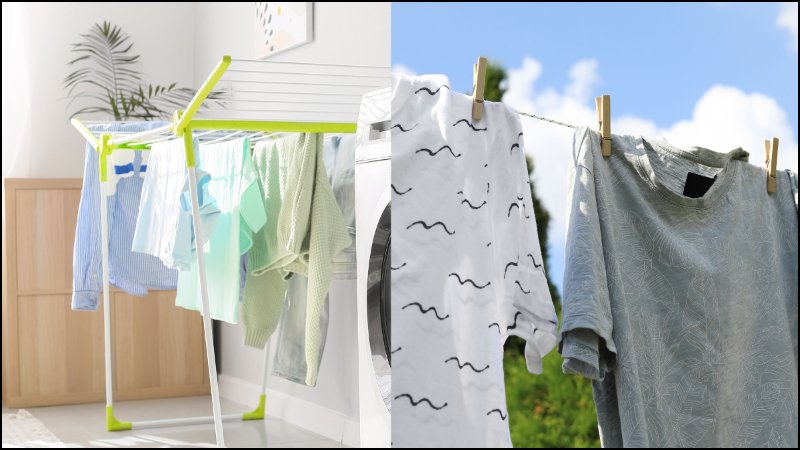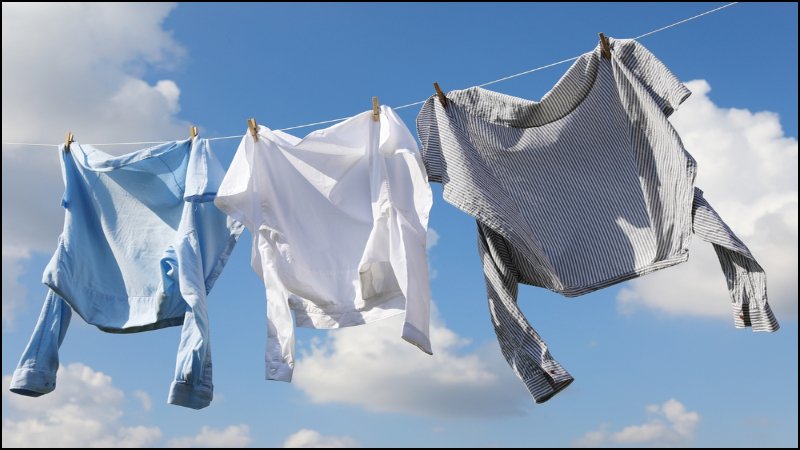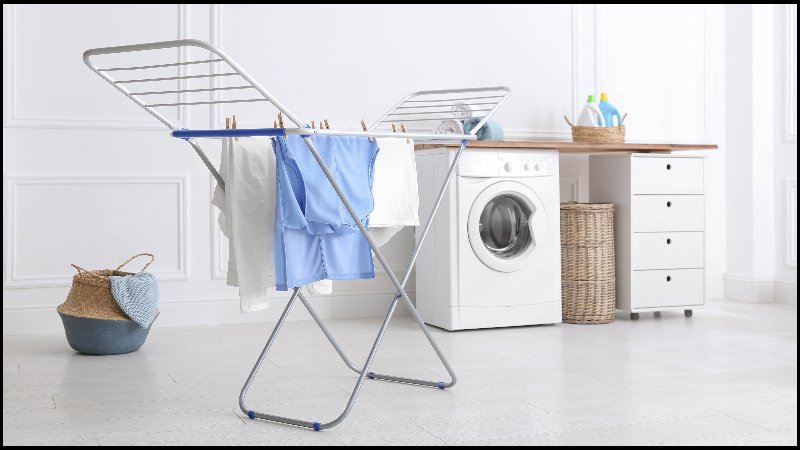Air Dry vs Tumble Dry: Best Way to Dry Clothes? Pros and Cons
Laundry day dilemma: dryer or clothesline? Air drying and tumble drying both get the job done, but impact your clothes, wallet, and the planet differently. This guide provides a detailed comparison, offering expert insights and practical advice. Learn to save money, protect your clothes, and make eco-conscious laundry choices! Let’s read it!
1. Air Drying: The Natural Choice
1.1 What is Air Drying?
Air drying is the time-tested method of drying clothes using natural evaporation. It involves hanging clothes on a clothesline (outdoors) or a drying rack (indoors or outdoors) and allowing them to dry through exposure to air. Sunlight and airflow often aid the process.
This method relies on the simple principle of evaporation, where moisture in the clothes is gradually released into the surrounding air. It’s a straightforward and environmentally friendly approach, requiring no energy input beyond the effort of hanging the clothes.

1.2 The Pros of Air Drying: Gentle, Green, and Wallet-Friendly
Air drying offers a compelling combination of benefits:
- Cost-Effective & Energy-Efficient: Air drying eliminates electricity or gas usage, resulting in significant savings on energy bills. A typical dryer uses a substantial amount of energy, costing a considerable amount per load.
- Eco-Friendly: Air drying is a zero-emissions process, reducing your carbon footprint and contributing to a more sustainable lifestyle. It’s a responsible choice for environmentally conscious individuals.
- Fabric Preservation: Air drying is exceptionally gentle on fabrics. The absence of harsh heat and reduced mechanical stress prevent fiber damage, shrinkage and wear and tear. This extends the lifespan of your clothes, especially delicate items.
- Potential for Wrinkle Reduction: The weight of water in damp clothes can help to gently stretch out wrinkles. However, proper hanging techniques are crucial for this to be effective.
- Fresh Scent & Natural Disinfection: Clothes dried in fresh air often have a pleasant, natural scent, especially when using eco-friendly detergents. Sunlight’s UV rays act as a natural bleaching and disinfecting agent, helping to kill bacteria and brighten whites.
- Static Elimination: Air drying clothes can be a great way to reduce static cling because of the moisture that is left in the fabric
1.3 The Cons of Air Drying: Patience and Weather Required
While air drying offers many advantages, it also has some limitations:
- Weather Dependency: Air drying is heavily reliant on favorable weather conditions. Rain, high humidity or extreme cold can make outdoor drying impossible. However, indoor air drying options are available.
- Time-Consuming: Air drying takes considerably longer than tumble drying, often requiring several hours or even overnight. This is a trade-off for the benefits it provides. Planning laundry days around weather forecasts can help.
- Effort Required: Hanging and arranging clothes requires some manual effort. However, efficient hanging techniques and user-friendly drying racks can minimize this.
- Musty Smell Risk: A musty smell can develop if clothes are left damp for too long before hanging or if airflow is insufficient. Prompt hanging, generous spacing and proper ventilation are crucial to prevent odors.
- Indoor Humidity: Drying clothes indoors can increase humidity levels, potentially leading to mold growth in poorly ventilated spaces. Opening windows, using exhaust fans or employing dehumidifiers can mitigate this risk.
1.4 Expert Tips for Effective Air Drying
Maximize the effectiveness of air drying with these expert tips:
- Shake it Out: Vigorously shake out clothes before hanging to minimize wrinkles and speed up drying.
- Invest in Quality: Use sturdy hangers and well-designed drying racks for better airflow and support.
- Space it Out: Space clothes adequately on the line or rack to allow for optimal air circulation around each garment.
- Ventilate: Choose a well-ventilated area, indoors or outdoors to facilitate faster evaporation.
- Shade for Darks: Dry dark-colored clothes in the shade to prevent potential fading from direct sunlight.
- Fabric-Specific Hanging: Consider the fabric type; lay delicate sweaters flat to prevent stretching.
2.1 What is Tumble Drying?
Tumble drying is a method of drying clothes using an electric or gas-powered machine. A tumble dryer circulates warm air within a rotating drum, causing the moisture in the clothes to evaporate. This process is known for its speed and convenience. The key features of tumble drying are its reliance on technology, its rapid drying times and its ability to dry clothes regardless of weather conditions.

2.2 The Pros of Tumble Drying: Fast, Fluffy, and Fuss-Free
Tumble drying offers several compelling advantages:
- Speed and Convenience: This is the primary benefit. Tumble dryers can dry a full load of laundry quickly, often in under an hour. This is ideal for busy lifestyles and urgent laundry needs.
- Wrinkle Removal (and softening): The tumbling action and warm air effectively reduce wrinkles and soften fabrics. Many modern dryers have “Wrinkle Prevention” settings for even better results.
- All-Weather Reliability: Tumble dryers are independent of weather conditions. They provide a reliable drying solution regardless of rain, snow or humidity.
- Softness and Fluffiness: The mechanical action within the dryer drum fluffs up fabric fibers, resulting in exceptionally soft and fluffy towels, bedding and other items.
- Bacteria and Allergen Reduction: The high heat in dryers can help sanitize clothes, reducing bacteria, dust mites and allergens. This is beneficial for individuals with sensitivities.
2.3 The Cons of Tumble Drying: Energy Hog and Fabric Foe?
Despite its convenience, tumble drying has significant drawbacks:
- Energy Consumption & Cost: Tumble dryers are energy-intensive appliances. They contribute to higher utility bills and a larger carbon footprint. Choosing energy-efficient models and using moisture sensors can help mitigate this.
- Fabric Wear & Tear: The combination of heat and mechanical tumbling can be harsh on fabric fibers. This can lead to damage, shrinkage, fading and a shorter lifespan for clothes, especially delicates. Using appropriate heat settings and avoiding over-drying are crucial.
- Wrinkle Creation (if not careful): While dryers can reduce wrinkles, improper use, particularly over-drying, you can actually cause wrinkles to set in. Remove clothes promptly when dry and utilize cool-down cycles.

2.4 Expert Tips for Smarter Tumble Drying
Optimize your tumble drying with these expert tips:
- Sort Smart: Sort laundry by fabric type and drying needs before tumble drying. This allows you to use the appropriate heat settings for each load.
- Sensor Savvy: Utilize moisture sensor settings if your dryer has them. These automatically stop the cycle when clothes are dry, preventing over-drying and saving energy.
- Lint is the Enemy: Clean the lint filter after each drying cycle. This maintains dryer efficiency and prevents fire hazards.
- Low Heat is Best: Opt for lower heat settings whenever possible, especially for delicate fabrics. This minimizes damage and shrinkage.
- Dryer Balls to the Rescue: Consider using dryer balls. These help improve drying efficiency, reduce static and soften fabrics naturally.
3. Choosing Your Drying Champion: Air Dry or Tumble Dry?
3.1 Fabric Type is Key
Fabric type is a primary consideration when choosing a drying method:
- Delicates (silk, lace, lingerie): Always air dry. This is the safest and gentlest option, preserving delicate fibers and intricate details.
- Synthetics (activewear, polyester): Air dry or tumble dry on low heat. High heat can damage synthetic fibers and affect their performance properties.
- Cotton (t-shirts, jeans): While cotton can tolerate tumble drying, air drying is preferable for extending lifespan and preventing shrinkage over time.
- Linens: Air drying is generally recommended for linen to maintain its texture and minimize wrinkles. However, a brief tumble dry on low heat initially can help soften new linen items.
- Wool: Always air dry wool garments flat to prevent felting, shrinkage and distortion.

3.2 Consider Your Lifestyle and Priorities
Your lifestyle and priorities also play a significant role:
- Eco-conscious & Budget-minded: Air drying is the clear winner. It’s the most environmentally friendly and cost-effective option.
- Time-strapped & Convenience-focused: Tumble drying is more practical for busy schedules. It offers speed and convenience that air drying cannot match.
- Value Fabric Longevity: Air drying is superior for preserving the quality and extending the lifespan of your clothing investments.
3.3 The Best of Both Worlds: Combining Methods
A balanced approach often yields the best results. Consider combining air drying and tumble drying:
- Air dry whenever feasible: During good weather for delicate items and for everyday clothes when time allows.
- Tumble dry strategically: For bulky items like bedding, during time crunches or when softness is desired.
- This flexible approach allows you to reap the benefits of both methods, optimizing for fabric care, convenience and environmental impact.
3.4 Specific Items: Bedding, Towels, and More
This section offers tailored drying recommendations for various common household items, helping you choose the best method for each category. Here’s a breakdown of drying recommendations for specific items:
- Bedding: Tumble drying is often preferred for bedding due to its convenience and the resulting softness, especially for large items. However, occasional air drying can reduce wear and tear and save energy.
- Towels: Tumble drying is excellent for making towels fluffy and soft. Air drying is a viable alternative for energy saving though it may result in a slightly rougher texture.
- Delicate garments (lingerie, silk): Always air dry these items. Their fragile nature makes them highly susceptible to damage from the heat and agitation of a tumble dryer.
- Sturdy items (jeans, denim jackets): These can withstand tumble drying but air drying can help prevent shrinkage and maintain their original fit for longer.
- Activewear: Air dry activewear to preserve the elasticity of spandex and the performance properties of technical fabrics. Dryer heat can damage these materials over time.
3.5 Additional Considerations: Washer-Dryer Combos vs. Separates
This section compares washer-dryer combos and separate units, highlighting the drying-related pros and cons of each. Choosing the right setup depends on your space, budget and laundry needs. Here’s a comparison focusing on drying performance:
| Pros | Cons | |
| Washer-Dryer Combos | Space-saving (ideal for small apartments or homes), all-in-one convenience (no need to transfer clothes between machines). | Smaller drum capacity (limiting the size of loads you can dry), generally less efficient drying performance (longer drying times), longer overall cycle times (washing and drying combined), potential for repairs affecting both washing and drying functions. |
| Separate Units (Washing Machine and Dryer) | Larger capacity for both washing and drying, more efficient and faster drying cycles, better overall drying performance, ability to run wash and dry cycles simultaneously, potentially longer lifespan for each individual unit. | Requires more space, higher initial purchase cost. |
4. FAQs about Drying Clothes
4.1 How can I air dry clothes indoors without making my house damp?
To minimize indoor humidity when air drying:
- Ensure good ventilation: Open windows or use exhaust fans to promote air circulation.
- Space clothes out: Don’t overcrowd drying racks; allow ample space between garments.
- Use a dehumidifier: In very humid conditions, a dehumidifier can help remove excess moisture from the air.
4.2 Will tumble drying always shrink my clothes?
No, tumble drying doesn’t always cause shrinkage but high heat and over-drying significantly increase the risk. Always use appropriate heat settings (low for delicates, medium for most items) and follow fabric care labels to minimize shrinkage.
4.3 Is it really cheaper to air dry clothes?
Yes, air drying is significantly cheaper in the long run. Tumble dryers are energy-intensive appliances and their usage contributes to your electricity or gas bill. Air drying, on the other hand, uses no energy, resulting in zero cost.
4.4 What fabrics should never be tumble dried?
Certain fabrics are highly susceptible to damage from tumble drying and should always be air-dried:
- Silk
- Lace
- Wool (especially knitted wool)
- Lingerie
- Items with delicate embellishments (beads, sequins, etc.)
- Certain synthetics
4.5 How long does air drying take compared to tumble drying?
Air drying takes significantly longer than tumble drying. Air drying can take anywhere from several hours to a full day (or even longer for very thick items), depending on factors like fabric thickness, humidity and airflow. Tumble drying typically completes in under an hour.
5. Packlove – Your Partner in Garment Care
Packlove understanding proper fabric care is essential for ensuring garment longevity and customer satisfaction. Choosing the right drying method is a crucial aspect of garment care. At Packlove, we deeply understand the importance of clear and accurate garment care instructions, which is why we are dedicated to providing high-quality care labels and tags.
We offer a comprehensive range of labeling and packaging solutions, including custom labels, tags, zipper bags, and poly mailers. These products help clothing businesses effectively communicate care instructions to customers and enhance their overall brand presentation.
Read more:
This guide has explored the two primary methods of drying clothes: air drying and tumble drying. Both are valuable, each with distinct advantages and disadvantages. The “best” method isn’t universal; it depends on individual needs, fabric types, lifestyle and priorities. Consider integrating both air drying and tumble drying into your routine for optimal results, adapting your approach based on the specific needs of each garment and your personal circumstances.






















